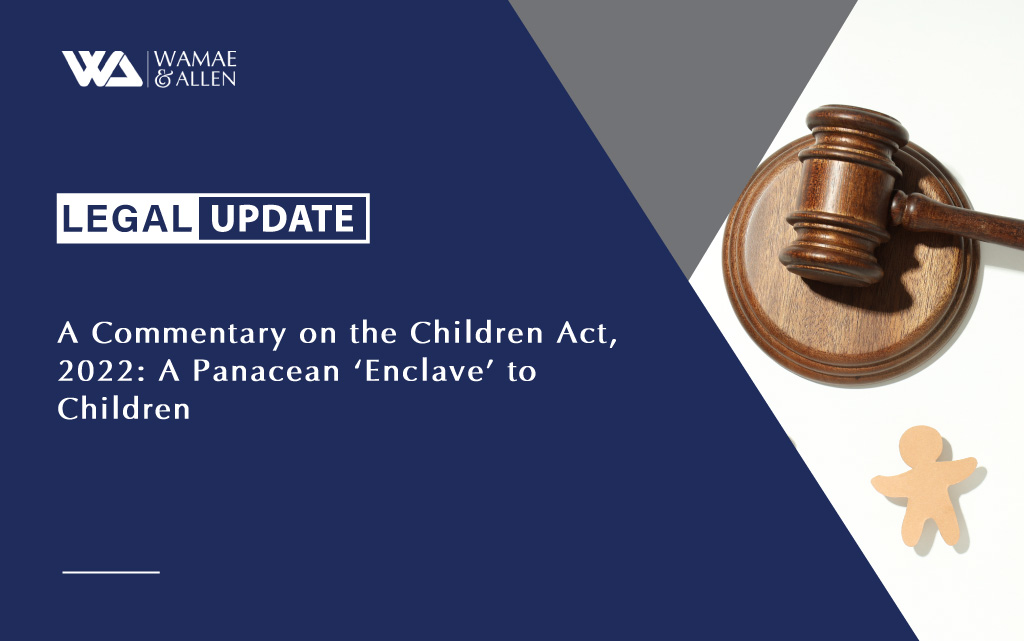Introduction
It is well within our knowledge that the Children Act 2022 (hereinafter referred to as the “Act”) repealed the old Children Act of 2001 (hereinafter referred to as the “repealed Act”). The new law is progressive by mirroring and protecting children in this contemporary world. The main objectives of the Act include primarily giving power to Article 53 of the Constitution of Kenya, by making expansive provisions on the rights of children, children in need of care and protection, parental responsibilities, alternative care, children in conflict with the law, children services administration and even the establishment and regulation of the National Council for Children’s Services.
Coming almost twelve years after the promulgation of the Constitution of Kenya, the Act is progressive, informed and supported by other Acts that speak to matters children, for instance, the Births and Deaths Registration Act, the Basic Education Act, 2013, the Legal Aid Act, 2016, the Victims Protection Act, 2014, the Counter Trafficking in Persons Act, 2010, the Sexual Offences Act, 2006, the Protection Against Domestic Violence Act, 2015 and not forgetting the two internationally acclaimed treaties, the Convention on the Rights of the Child and the African Charter on the Rights and Welfare of Children.
Notable provisions
- Best interests of the child’s considerations
It is worth noting that the first schedule of the new Children Act 2022 has laid down elaborate considerations on the Best interest of the child consideration. It cements the inoculation created by Article 53(2) of the Constitution of Kenya against adverse actions, omissions, considerations and treatment that might be meted against a child.
Specifically, the second schedule is centred around the following reflections, as an embodiment of the best interest of a child:
- The age, maturity, developmental stage, background and gender;
- Special needs from taking into account the peculiar nature of each individual child;
- The relationship the child has with the parent(s);
- The viability, adequacy, and duration of the child’s living arrangements;
- Stability in favour of the child;
- Adjustment to the child’s present home, school and community;
- The capability and viability of shred custody;
- Cooperation of the parents/guardians toward the child care;
- Existence of domestic abuse, child abuse; or
- Where the child is under one year or is being breastfed;
- Conviction of a parent/guardian on a sexual or violent offence under the Sexual Offences Act; or
- Other reasonable factors.
This is a great stride towards codifying key highlights that ought to be considered when deciding on matters relating to children.
The repealed Act did not contain elaborate provisions on the Best interests of a child. Under Section 4(2) and (3) of the repealed Act, there was only a mention of the same. The rest was left to judge-made laws, legal importation from other jurisdictions, and regional and international treaties thereby giving a wide berth as to the certainty of considerations to be taken.
The Children Act 2022 has been cognizant of the judicial decisions made over the years in the child’s best interests. For instance, in the case of EKM v EBO [2020] eKLR Justice Chacha Mwita restated what Lord Kerr specified in the case of ZH (Tanzania) (FC) v Secretary of State for the Home Department [2011] UKSC 4:
“[48] “It is a universal theme of the various international and domestic instruments to which Lady Hale has referred that, in reaching decisions that will affect a child, a primacy of importance must be accorded to his or her best interest. This is not, it is agreed, a factor of limitless importance in the sense that it will prevail over all other considerations. It is a factor, however, that must rank higher than any other. It is not merely one consideration that weighs in the balance alongside other competing factors. Where the best interests of the child favour a certain course, that course should be followed unless countervailing reasons of considerable force displace them. It is not necessary to express this in terms of a presumption but the primacy of this consideration needs to be made clear in emphatic terms. What is determined to be in a child’s best interests should customarily dictate the outcome of cases such as the present, therefore, and it will require considerations of the substantial moment to permit a different result.”
-
Criminal liability of a child
The Children Act 2022 has brought in a new development in the criminal sphere. As per Sections 2 and 221(1) of the Act, there is an entrenched blanket provision that a person under the age of twelve (12) years cannot be criminally liable for any act or omission. Section 2 of the Act accepts that a child in conflict with the law excludes a child below the age of twelve (12) years. Section 221 (2) moreover provides that a child that has committed an offence under the age of fourteen (14), is presumed not to have the capacity to differentiate between right and wrong unless the court is satisfied otherwise.
It is worth noting that this provision has usurped Section 14 (1) of the Penal Code which provides verbatim that a person under the age of eight years is not criminally responsible for any act or omission. Moreover, subsection 2 of the same section excluded children from criminal liability unless the court was satisfied that thy had the capacity to differentiate right and wrong. This has also been increased to 14 years in the new Act. The widening of the berth on the number of years for children in conflict with the law aims at protecting more children, who may not be well developed mentally to discern right from wrong.
-
Legal Aid Fund
The Act borrows and is supplemented by the Legal Aid Act, 2016 when it comes to children’s representation. Specifically, Section 96(1) empowers children complainants under the age of sixteen (16) years in need of representation to be assisted on the same through the legal aid kitty. In other words, any legal fees for that particular representation shall be charged on the Legal Aid Fund.
It is a step in the right direction that the new Act has elaborately provided for the use of the Legal Aid Fund in that specific circumstance. In contrast, the repealed Act under Section 77 provided that where an unrepresented child is brought before a court, the court may order that the child be granted legal representation and any expenses incurred in relation to the legal representation of the child under shall be defrayed out of monies provided by Parliament. This section of the repealed law was absurd due to the uncertainty of where the expenses would be gotten from. The new Children Act 2022 now, clearly, definitely and elaborately directs the legal expenses to be severed from the Legal Aid Fund.
-
Parental Responsibility
It is worth noting that under Part III of the new Children Act 2022, an equal parental responsibility has been placed upon both parents and/or guardians of the children under Section 31.
Equal parental responsibility has been a bone of contention, especially between mothers and fathers after a divorce. With the coming of the new Act, coupled with the case of PKM v ANM [2020] eKLR where a judge gave an equal parental responsibility to the parents towards the payment of school fees for the child until further orders were made.
-
Intersex children
It is a sigh of relief for children and parents of intersex children after a long fight and struggle, for the new Children Act 2022 finally recognizes them. In one of the famous cases by Justice Isaac Lenaola who sympathized with intersex children in the case of Baby ‘A’ (Suing through the Mother E A) & another v Attorney General & 6 others [2014] eKLR to the extent of ordering data to be taken on intersex persons living in Kenya as such data was important in making and designing policies to protect intersex persons as a group of marginalized persons.
Informatively and recognizably, Section 2 of the Act has defined intersex children elaborately to mean a child with a congenital condition in which the biological sex characteristics cannot be exclusively categorised in the common binary of female or male due to inherent and mixed anatomical, hormonal, gonadal or chromosomal patterns, which could be apparent prior to, at birth, in childhood, puberty or adulthood.
Under Section 7 of the new Act, the Principal Registrar of Births has been instructed to take measures towards the registration of intersex children as such. Further, Section 21 has provided that an intersex child shall have the right to be treated with dignity, and to be accorded appropriate medical treatment, special care, education, training and consideration as a special need category in social protection services. Moreover, Section 26(3) and 64(3) of the Act stresses the importance of having separate holding facilities and children protection units respectively desegregated by gender.
To appreciate this step, it is worth noting that the repealed Act had absolutely no mention of intersex children, leaving them out to dry with regard to the protection of their rights as a special group.
-
Adoption parameters
The adoption parameter has been made a bit easier for relatives. The new Children Act 2022 under Section 186 (3) a twenty-five years qualification age for adopting a child does not apply to relatives. This will therefore make it easier for an adult who has attained the age of 18 but not 25, to be able to adopt children in their familial lineage unlike Section 148(1) of the repealed Act that blanketly disqualified any person, including relatives, from adopting a child if they were below the age of twenty-five years.
-
Cyberbullying and sexual exploitation online
Due to the rise and rise of social media and the internet in the contemporary world, children need to be protected. The repealed Act had no mention of Cyberbullying. However, the new Act definitely grounds provisions geared toward the protection of children against cyberbullying under Section 22(4), (5) and (6). These provisions are to be read and supported by the Computer Misuse and Cybercrimes Act Number 5 of 2018.
A person convicted of cyberbullying or stalking or sexual exploitation of a child online shall be liable to imprisonment for a term not exceeding ten years or to a fine not exceeding two million shillings, or to both.
-
Diversion
Sections 224, 226 and 227 of the new Children Act 2022 now codifies the concept of diversion of children cases, unlike the previous Act. Diversion is a process whereby children in conflict with the law are dealt with outside the formal criminal justice system and in particular from formal court processes. It promotes the reintegration of such children into society and has been viewed as an important element of restorative justice as it includes the development of strategies aimed at reforming such children involved in criminal activities.
As the best interest of a child, UNICEF has over the years advocated for the use of diversion in channelling children in conflict with the law away from court trials by urging states to develop and implement programmes, procedures and structures that help children avoid criminal records. As much as a diversion has been a policy practised in Kenya, the new Act has codified it.
-
Family-based care
The Act through its provisions has keenly prioritized and encouraged family-based care through fostering, adoption, custody, maintenance, guardianship, kinship care, kafaalah among others. Relatives-related adoption would now be much faster devoid of unnecessary hurdles as a child’s best interest might sometimes be to remain within the family lineage and ties. The Children Act 2022 gives priority to family-based alternative care as opposed to the institutionalization of children in Children’s Homes.
-
Social security Right
It is important to note that the new Act under Section 12(7) has mandated the Cabinet Secretary responsible for matters relating to finance to establish a fund under the Public Finance Management Act No. 18 of 2012 to be known as the Child Welfare Fund for facilitation of the realization of the right guaranteed by Article 43(3) of the Constitution in respect of all reasonable expenses incurred in relation to alternative care and other social security programmes designed to facilitate the realisation of the welfare of the child.
Conclusion
The Act’s progression is notable. The changes brought in go a long way towards the protection of the modern child. The Act creates a clear picture of its determination to promote the protection of a child by enhancing the best interests of the child succinctly.
The Act also promotes adequate allocation of resources to child welfare programmes, effectively co-ordinate all stakeholders in the child protection sector so as to enable children to better access the services that they offered, safeguards children’s right to parental care and inclusion of alternative care services, and in the spirit of devolution, it makes provisions for the roles of the county governments in discharging their mandate towards the administration of children’s services. These include developing policies on children’s matters, establishing child care facilities, as well as facilitating access to pre-primary education, play and recreational centres for children.
This article is provided free of charge for information purposes only; it does not constitute legal advice and should be relied on as such. No responsibility for the accuracy and/or correctness of the information and commentary as set in the article should be held without seeking specific legal advice on the subject matter. If you have any query regarding the same, please do not hesitate to contact Litigation vide litigation@wamaeallen.com
Read more updates: LEGAL UPDATES
